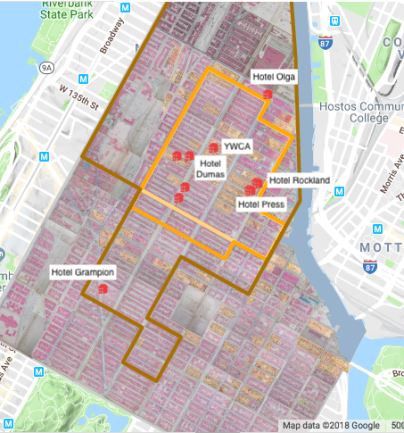In Harlem, cricket was a game almost exclusively played by West Indian immigrants. The game had a prominent place in the West Indian community even before they relocated to Harlem. One indication of the importance of cricket was that events that sought to bring together West Indians typically gave out prizes to the cricket club… Continue reading Cricket in 1920s Harlem
Category: Events
1920s Harlem as a Destination
Summer did not just lead residents to depart Harlem for day trips and longer summer camps; it also brought visitors to the neighborhood. Some came as individuals to study or see family, friends and the city's attractions, others as groups for large events. Evidence of the presence of middle-class tourists in Harlem exists thanks to… Continue reading 1920s Harlem as a Destination
Mapping a Riot: Harlem, 1935
Cross-posted from drstephenrobertson.com On March 19, 2016, I participated in the Working Group on Interpreting the History of Race Riots and Racialized Mass Violence in the Context of “Black Lives Matter,” at the National Council on Public History Conference, in Baltimore. Prior to the meeting, members of the Working Group contributed short posts on their projects… Continue reading Mapping a Riot: Harlem, 1935
Numbers on Harlem’s Streets
Numbers gambling formed part of the rhythm of Harlem's street life. A map of arrests for playing the numbers in 1925 features almost every corner on Fifth, Lenox, Seventh and Eighth Avenues. Those arrests generally took place in the morning, when players seeking to place bets on their way to work and before before the… Continue reading Numbers on Harlem’s Streets
Hubert Julian in Harlem
Hubert Julian, by his own account, arrived in Harlem in 1921. Born in Trinidad in 1897, he had migrated to Canada in 1914, where he claimed to have learned to pilot an aeroplane and served as a Lieutenant in the Canadian Air Force, and came from there to New York City. His first appearance above… Continue reading Hubert Julian in Harlem
Harlem and Baseball in the 1920s
In 1911, Harlem gained its own black professional baseball team, the Lincoln Giants. The white brothers, Edward and Jess McMahon, established the team, obtaining a lease on Olympic Field, at 136th Street and 5th Avenue, where the team played home games on Sundays, the only day off for most black workers. Initially managed by Sol… Continue reading Harlem and Baseball in the 1920s
Basketball in 1920s Harlem
Sports loomed large among the entertainments patronized by Harlem's residents in the 1920s. Basketball occupied the most prominent place. Romeo Dougherty, sportswriter for the Amsterdam News, argued that, "Here in Greater New York and New Jersey basketball has meant more to us than baseball for the latter sport among colored people has been so closely… Continue reading Basketball in 1920s Harlem
The Universal Negro Improvement Association (UNIA) in Harlem
Marcus Garvey's Universal Negro Improvement Association (UNIA) was headquartered in Harlem from 1918 to 1927. The organization generally appears in accounts of Harlem on parade, on the occasion of its conventions. However, the UNIA occupied more than the streets. Its headquarters was on West 135th Street, as were the offices of a number of the… Continue reading The Universal Negro Improvement Association (UNIA) in Harlem
Parades in 1920s Harlem
Harlem is also a parade ground. During the warmer months of the year no Sunday passes without several parades. There are brass bands, marchers in resplendent regalia, and high dignitaries with gorgeous insignia riding in automobiles. Almost any excuse for parading is sufficient -- the funeral of a member of the lodge, the laying of… Continue reading Parades in 1920s Harlem
New Feature: Mapping the path of an event
A new feature has been added to Digital Harlem, thanks to the folks at the Archaeological Computing Laboratory. It is now possible to link the path of an event. This is most obviously useful for mapping events such as parades. If you map the July 4th parade of members… Continue reading New Feature: Mapping the path of an event











